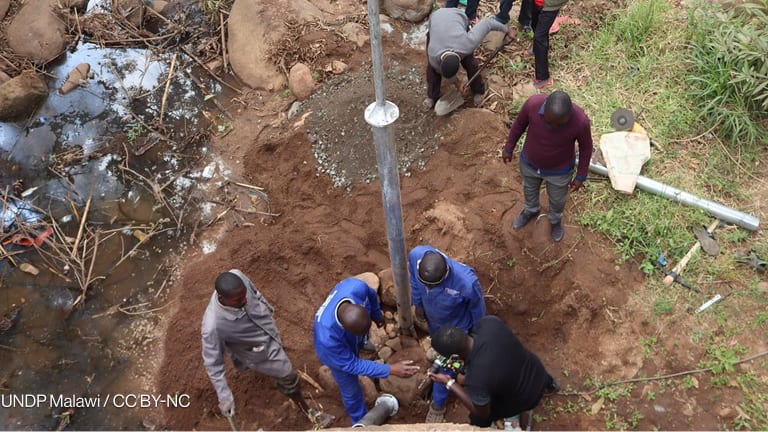
Food insecurity is often an underappreciated consequence of climate change. Rising temperatures and more frequent extreme weather threaten to change the way we grow our food in the coming decades. Meanwhile, the world’s population is projected to grow to 9.7 billion by 2050 and disposable incomes are rising, so we’ll have to produce up to 70 percent more food.
To make matters even more complicated, populations are set to grow the most in the very regions that will likely suffer the worst impacts from climate change and are already the most food insecure. According to the United Nations, by 2050 “the populations of 28 African countries are projected to more than double, and by 2100, 10 African countries are projected to have increased by at least a factor of five.”
Farmers in developing countries are often among those most vulnerable to food insecurity, given their limited capacity to respond to climate shifts and unpredictable market responses. Their contribution to the local, regional, and global food supply, however, is undeniably significant. For this reason, the planet’s resilience depends on theirs as much as any. Tools and technology to ensure farmer resiliency are critical to ensuring food security globally, now and into the future.
Lessons learned from crisis simulation
Fortunately, there are ways to achieve that goal. At Food Chain Reaction, a crisis simulation held last month in Washington, D.C., 65 leaders and experts from around the world gathered to game out how the public and private sectors would respond to the impacts of climate change on the world’s food supply. Over two days, they were subjected to a mounting series of fictional — but altogether plausible — climate calamities, including heat waves and pests decimating U.S. harvests, faltering monsoons wreaking havoc on India’s agriculture, massive floods driving millions from their homes in Bangladesh, and widespread famine causing civil unrest across Africa.
Live from the #Paris climate conference
Devex is live in Paris with updates on the COP21 summit and what it means for global development cooperation. Bookmark this live-blog to follow our reporters on the ground.
In the end, the players emerged with an array of solutions, many of which would benefit developing countries, including an internationally financed infrastructure fund for Africa and other key regions around the world, joint water management schemes for rivers in Southeast Asia, initiatives to share technology and information, and an early warning system for famines.
What became abundantly clear, if it wasn’t already, is that developing nations will have an increasingly crucial role to play in coming decades. Population growth will continue, and climate change does not differentiate between developed or developing, vulnerable or secure. Indeed, given how interconnected our food system is, when one region of the globe suffers climate-induced agricultural setbacks, other places will have to step in and make up for shortfalls.
We must find ways to enable producers to increase agricultural production without depleting the planet’s resources — such as its forests, grasslands and fresh water systems — and putting further pressure on our climate. Our growing population will depend on a global food system that can absorb the shocks we know are coming.
How to help build a healthy food system
Building a strong foundation for agriculture is no simple task. The good news is there are approaches, tools, and technologies available off-the-shelf right now that, if managed appropriately, can increase yields in developing countries. Corn yields per hectare in the U.S., for instance, are 10 times greater today than they are in sub-Saharan Africa, where much of the world’s remaining arable land is found. By applying present-day seeds fertilizers, and pest management strategies used in the U.S., for example, countries in sub-Saharan Africa can significantly amplify their agricultural productivity even without relying on “bleeding edge” technology.
Access to these tools and technologies, as well as proper management training and capacity building, are also essential to ensure they are implemented without harming soils, water, or biodiversity. Precision agriculture can be extended to small farmers around the world with an understanding that access to capital and technology enabling it should be packaged together.
Drought resistant and heat tolerant crops are available as well, with more in development. Their use, if restricted to areas suitable for agriculture, can also contribute to a healthy food system.
That, of course, is easier said than done. It would take initiatives like the international infrastructure fund proposed during the Food Chain Reaction simulation and prolonged investments by the private sector. Furthermore, for these to be operational requires political stability, removal of corruption, legal enforcement, and environmentally, socially and economically sustainable policies. But, as the crisis simulation showed, the elements for dramatic improvement are available.
A renewed sense of urgency
Food Chain Reaction was, of course, only a game. Nobody had to ask skeptical electorates to swallow higher taxes at home to pay for measures that benefited other countries. But the exercise did show that when policymakers from national governments, multilateral institutions, nongovernmental organizations, and business come together and truly commit to strategic action, solutions can arise.
What is needed now is the sense of urgency to make it happen in the real world. Indeed, the U.N. projects that 20 countries — 18 in sub-Saharan Africa plus Syria and Iraq — will see their populations increase by more than 45 percent within the next 15 years. With COP21 climate talks in full swing in Paris, we hope negotiators can muster the resolve to rise above the disagreements that derailed previous climate discussions, and be decisive about steering global greenhouse gas emissions downward. A welcome step further would be for ministers to decide to tackle the implications of climate change on food security and initiate a global dialogue about the role of different nations with differing degrees of vulnerability in a volatile new normal.
The best available climate science and demographic projections remove any excuse for inaction. We know we’ll need more food, we know what we can do to deliver it, and we need to get started now. We risk rising food prices, less food availability, de-prioritization of conservation concerns, suboptimal agricultural production, and social unrest. If we fail to strengthen the most vulnerable and food insecure places in the world today, we will all pay the price for that negligence tomorrow.
Planet Worth is a global conversation in partnership with Abt Associates, Chemonics, HELVETAS, Tetra Tech, the U.N. Development Program and Zurich, exploring leading solutions in the fight against climate change, while highlighting the champions of climate adaptation amid emerging global challenges. Visit the campaign site and join the conversation using #PlanetWorth.









